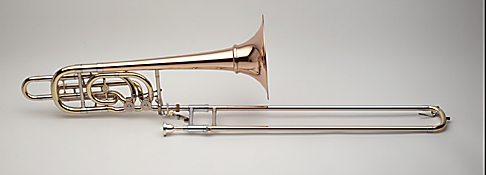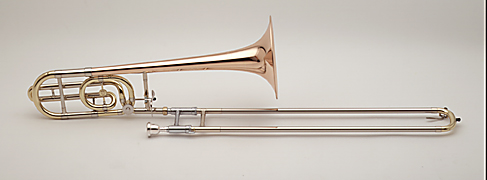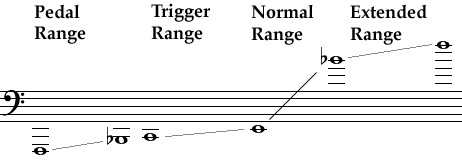trombone
[English]
HISTORY: The moden version of the sackbut. It was used for vocal doubling in church music and in small ensembles. The trombone was not used in the orchestra until the 18th century. The first prominent symphonic use was in Ludwig van Beethoven's Symphony #5. The modern family includes the Alto Trombone, Tenor Trombone, Bass Trombone, and Contrabass Trombone. It is also commonly referred to as the "slide trombone" or in some jazz slang as the sliphorn.
PHYSICAL DESCRIPTION: A family of brass instruments with a cylindrical bore and a slide rather than valves. The slide allows the performer to lengthen or shorten the length of tubing in the instrument, thus allowing the harmonic series to be altered, making the instrument fully chromatic.
SOUND PROPERTIES: Sound is produced (as in most brass instruments) by the vibration of the performers lips. As the performer moves the slide out, the length of the tubing is increased which lowers the pitch being sounded. Seven pitches are possible in each harmonic of the trombone that are reflected in the seven positions of the slide.
RANGE: The trombone has a normal chromatic range of E2 below the bass clef to B flat4 above middle C. Experienced performers are able to extend the upper range, often to F5 (or higher). A mechanical trigger mechanism (typically in F) can extend the chromatic range to low C2, and the bass trombone often has a second trigger mechanism to add the low B1 which extends the chromatic range into the pedal register, down to a pedal F (F1 ).
Example
 Bass Trombone (with F and G Triggers)
Bass Trombone (with F and G Triggers)Photo courtesy of G. Leblanc Corporation
 Tenor Trombone (with F Trigger)
Tenor Trombone (with F Trigger)Photo courtesy of G. Leblanc Corporation
 Tenor Trombone
Tenor TrombonePhoto courtesy of G. Leblanc Corporation
 Trombone Range
Trombone Range
Igor Stravinsky: The Soldier's Tale I, "Soldier's March"
Ferde Grofé: Grand Canyon Suite, "On the Trail"
See Also
[French] trombone[German] Posaune
[Italian] trombone
[Spanish] trombón
Share
Tweet
Last Updated: 2016-05-11 20:47:20

